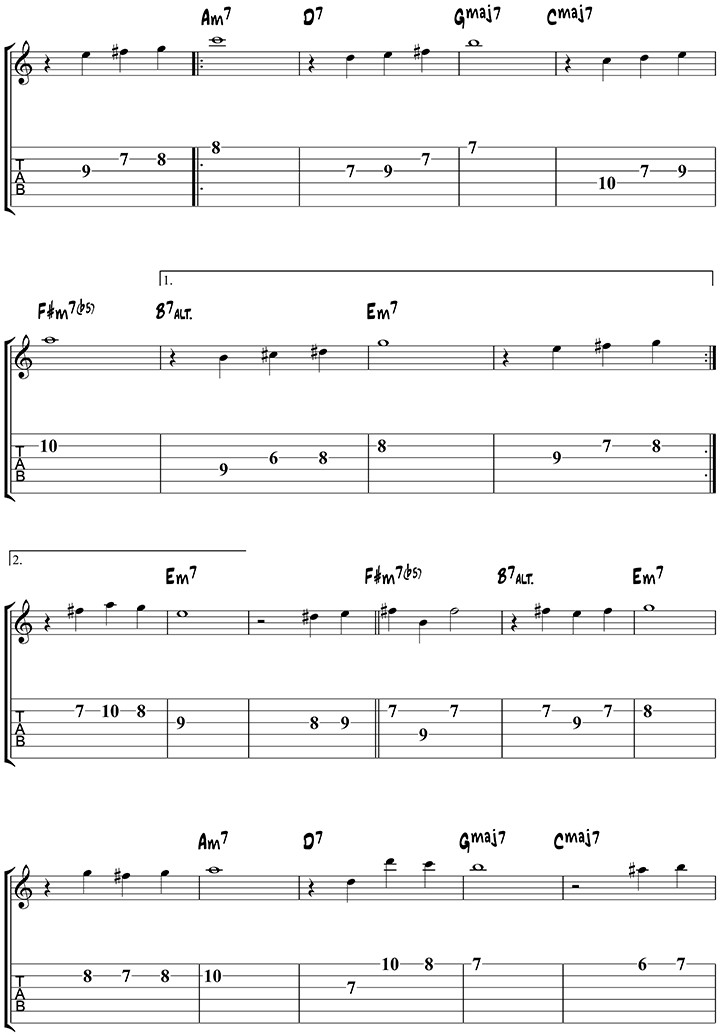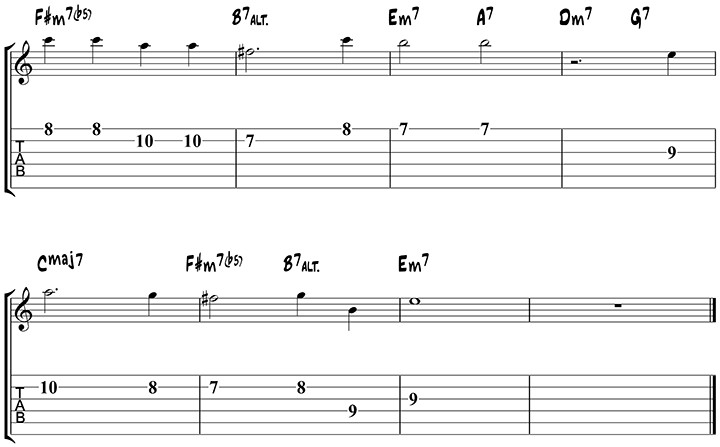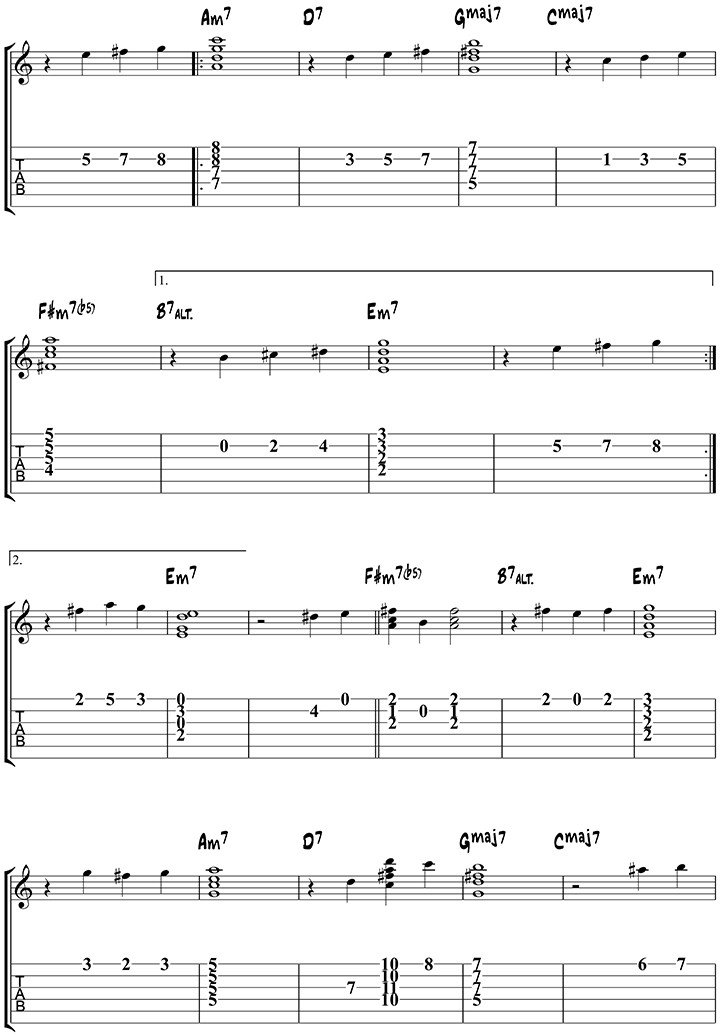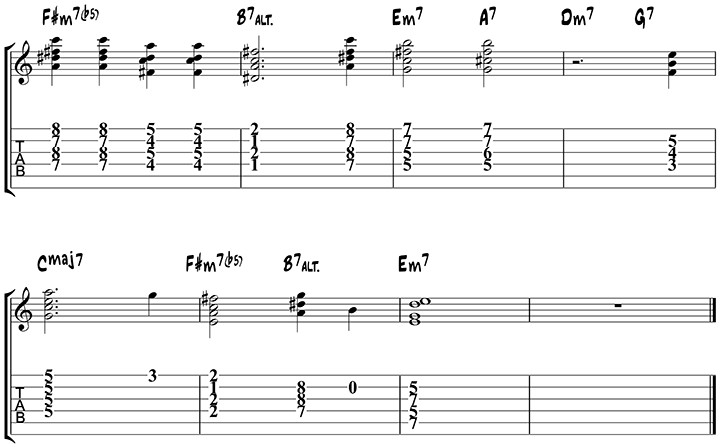Autumn Leaves guitar is a timeless jazz standard, and learning to play it unlocks a world of musical possibilities for guitarists of all levels. This comprehensive guide, brought to you by guitarplayers.net, will explore various approaches to playing Autumn Leaves on guitar, from basic chord progressions to advanced soloing techniques. Dive in and discover how to make this beautiful song your own!
1. What Makes “Autumn Leaves” a Must-Know for Guitarists?
Autumn Leaves is a cornerstone for any aspiring jazz guitarist because it is a jazz standard that offers diverse learning opportunities. The versatility of Autumn Leaves makes it an essential piece to master, enriching your musical understanding and expanding your guitar playing capabilities.
- A Standard Tune: Autumn Leaves is one of the most frequently played tunes in jazz jam sessions.
- Key Flexibility: The song can be played in both Em (E minor) and Gm (G minor).
- Essential Concepts: Playing this song introduces you to tunes commonly played in more than one key, therefore, you need to learn it in both keys.
- Chord Progressions: The song also features both major and minor ii V I progressions, crucial for comping and soloing.
- Melodic Potential: The melody is perfect for chord melody arrangements, allowing for creative exploration.
2. What Are the Benefits of Learning “Autumn Leaves” on Guitar?
Learning Autumn Leaves enhances your musical understanding and guitar skills because it is more than just learning a song. Here’s how mastering this tune can benefit you:
- Technical Skill: The song challenges you technically, pushing you to improve your finger dexterity and coordination.
- Versatility: It can be played at various tempos, making it adaptable to different performance settings.
- Ensemble Play: Autumn Leaves sounds fantastic in various ensemble settings, from solo performances to larger groups.
- Ear Training: Playing the song in different keys improves your ear training and ability to recognize chord progressions.
- Improvisation: The structure of the song provides a solid foundation for learning and practicing improvisation.
3. How to Approach Learning “Autumn Leaves” on Guitar?
Start with the melody and gradually add chords to effectively learn Autumn Leaves on the guitar. Begin with a simplified single-note version to grasp the melody, then move on to incorporating chords for a fuller sound.
- Single Note Melody: Start by learning the melody as a single-note line. This will help you internalize the tune and its phrasing.
- Chord Melody: Once you’re comfortable with the melody, begin adding chords. This involves playing the melody on the higher strings while incorporating chords below.
- Comping: Practice comping (playing chords) behind the melody. This will help you understand the harmonic structure of the tune.
- Soloing: Experiment with soloing over the chord changes. Focus on using scales and arpeggios that fit the underlying harmony.
- Key Variations: Learn the song in both Em and Gm to expand your understanding and versatility.
4. What Are the Essential Chords for “Autumn Leaves” on Guitar?
Understanding the chord progression is key to mastering Autumn Leaves on guitar, and it allows you to comp and solo effectively. Here’s a breakdown of the essential chords in both Em and Gm:
| Chord | Em Key | Gm Key |
|---|---|---|
| i | Em7 | Gm7 |
| ii | F#m7b5 | Am7b5 |
| V | B7 | D7 |
| I | Am7 | Cm7 |
| IV | Dmaj7 | Ebmaj7 |
| vi | Cmaj7 | Bbmaj7 |
These chords form the foundation of the song. Practice transitioning between them smoothly to create a solid harmonic base.
5. How to Play the “Autumn Leaves” Melody on Guitar?
Start with the melody of Autumn Leaves because it is a crucial first step for guitar players. This can be achieved through both a simple single note version and a chord melody arrangement.
5.1. Single Note Version
Learning the melody as a single note is a great way to start, and it helps you internalize the tune. Play along with the audio example to get the feel of the melody.
 Autumn Leaves Melody for Guitar 1
Autumn Leaves Melody for Guitar 1
 Guitar Tablature for Autumn Leaves Melody Part 1
Guitar Tablature for Autumn Leaves Melody Part 1
Guitar Tablature for Autumn Leaves Melody Part 2
5.1.1. Tips for Learning the Single Note Melody
Practice with these tips to improve your playing of the single note melody.
- Start Slow: Begin at a slow tempo and gradually increase the speed as you become more comfortable.
- Use a Metronome: Practice with a metronome to develop your timing and rhythm.
- Memorize the Melody: Work on memorizing the melody so you can play it without looking at the sheet music.
- Play Along: Play along with a backing track to simulate a real performance environment.
5.2. Chord Melody Version
Once you are comfortable with the single note version, start adding chords to enrich the melody. This easy chord melody version of Autumn Leaves is a perfect next step.
 Autumn Leaves Chord Melody 1
Autumn Leaves Chord Melody 1
 Guitar Chords and Melody for Autumn Leaves Part 1
Guitar Chords and Melody for Autumn Leaves Part 1
Guitar Chords and Melody for Autumn Leaves Part 2
5.2.1. Tips for Playing the Chord Melody
Apply these tips to master the chord melody effectively.
- Focus on the Top Notes: Emphasize the top notes of the chords to bring out the melody.
- Smooth Transitions: Practice smooth transitions between chords to maintain a fluid sound.
- Experiment with Voicings: Try different chord voicings to add variety and interest to your playing.
- Listen to Examples: Listen to recordings of other guitarists playing chord melody arrangements of Autumn Leaves for inspiration.
6. What Are the Key Changes and Progressions in “Autumn Leaves”?
Autumn Leaves features key changes and chord progressions that provide a rich harmonic landscape, and learning to navigate these changes is crucial for mastering the song. The tune primarily revolves around minor keys and includes both major and minor ii-V-I progressions.
6.1. Understanding the ii-V-I Progression
The ii-V-I progression is a fundamental building block in jazz harmony because it creates a strong sense of resolution and movement.
- Major ii-V-I: A common major progression in Autumn Leaves is Dm7 – G7 – Cmaj7.
- Minor ii-V-I: A common minor progression in Autumn Leaves is F#m7b5 – B7 – Em7.
6.1.1. Tips for Navigating the ii-V-I Progression
Mastering the ii-V-I progression can be done through the following tips.
- Practice Slowly: Practice the progressions slowly to internalize the sound and feel of each chord change.
- Use Different Voicings: Experiment with different voicings of the chords to create variety and interest.
- Improvise Over the Progression: Practice improvising over the ii-V-I progression using scales and arpeggios that fit the harmony.
- Listen to Examples: Listen to recordings of jazz musicians playing over the ii-V-I progression to get ideas and inspiration.
6.2. Analyzing the Key Changes
Autumn Leaves modulates between different keys, which adds depth and complexity to the song. Understanding these key changes is essential for comping and soloing effectively.
- From Em to Am: The song often moves from Em (E minor) to Am (A minor).
- From Gm to Cm: Similarly, the song can move from Gm (G minor) to Cm (C minor).
6.2.1. Tips for Adapting to Key Changes
To adapt effectively to key changes, make sure to follow these helpful tips.
- Identify the Key Centers: Be aware of the key centers and how they relate to each other.
- Use Pivot Chords: Use pivot chords to smoothly transition between keys.
- Practice Key Changes: Practice transitioning between keys to develop your ear and technique.
- Transcribe Solos: Transcribe solos from jazz musicians who are adept at navigating key changes.
7. What Scales and Arpeggios Should You Use for Soloing Over “Autumn Leaves”?
Selecting the right scales and arpeggios is crucial for creating compelling solos over Autumn Leaves, and understanding the underlying harmony of the song will guide you in your choices. Here are some essential scales and arpeggios to use when soloing:
| Chord | Scale/Arpeggio | Notes in E Minor |
|---|---|---|
| Em7 | E Dorian | E F# G A B C# D |
| F#m7b5 | F# Locrian | F# G A B C D E |
| B7 | B Mixolydian | B C# D# E F# G# A |
| Am7 | A Dorian | A B C D E F# G |
| Dmaj7 | D Lydian | D E F# G# A B C# |
| Cmaj7 | C Ionian | C D E F G A B |
7.1. Tips for Using Scales and Arpeggios Effectively
Apply these tips to enhance your soloing skills.
- Start Simple: Begin by focusing on a few key scales and arpeggios.
- Listen to the Changes: Pay attention to the chord changes and adjust your playing accordingly.
- Use Passing Tones: Incorporate passing tones to create melodic interest.
- Practice Regularly: Practice your scales and arpeggios regularly to develop your technique and ear.
- Transcribe Solos: Transcribe solos from jazz musicians who are adept at soloing over Autumn Leaves.
8. What Are Some Common “Autumn Leaves” Guitar Chord Voicings?
Experimenting with different chord voicings can add depth and color to your playing, and the right voicings can make your comping sound more interesting and sophisticated. Here are some common chord voicings for Autumn Leaves:
| Chord | Voicing 1 | Voicing 2 | Voicing 3 |
|---|---|---|---|
| Em7 | 022030 | 779787 | 12 14 12 12 12 12 |
| F#m7b5 | 2x223x | 9 x 9 10 10 x | x 11 12 11 12 11 |
| B7 | x21202 | 797877 | x 2 1 2 0 2 |
| Am7 | 5x555x | x02010 | 5 7 5 5 5 5 |
| Dmaj7 | xx0222 | 557675 | x 5 7 6 7 5 |
| Cmaj7 | x32000 | 8 10 9 9 8 8 | x 3 5 4 5 3 |
8.1. Tips for Using Different Chord Voicings
Make sure to use these tips when using different chord voicings to further enhance your performance.
- Experiment with Different Voicings: Try out different voicings to find the ones that sound best to you.
- Use Inversions: Use inversions to create smooth transitions between chords.
- Listen to Recordings: Listen to recordings of jazz guitarists to hear how they use different voicings.
- Practice Transitions: Practice transitioning between different voicings to develop your technique and ear.
9. How Can You Improvise Over “Autumn Leaves” on Guitar?
Improvising over Autumn Leaves can be both challenging and rewarding, and it allows you to express your creativity and develop your musical voice. Here are some tips for improvising over Autumn Leaves:
- Know the Harmony: Have a solid understanding of the chord changes and key changes in the song.
- Use Scales and Arpeggios: Use scales and arpeggios that fit the underlying harmony.
- Listen to Jazz Musicians: Listen to recordings of jazz musicians improvising over Autumn Leaves to get ideas and inspiration.
- Start Simple: Begin with simple melodic ideas and gradually add complexity as you become more comfortable.
- Record Yourself: Record yourself improvising and listen back to identify areas for improvement.
- Focus on Phrasing: Pay attention to your phrasing and articulation to create a musical and engaging solo.
- Tell a Story: Think of your solo as a story and try to create a sense of narrative and development.
10. What Are Some Common Mistakes to Avoid When Playing “Autumn Leaves” on Guitar?
Avoiding common mistakes can help you learn the song more efficiently and effectively, and it ensures that you are developing good habits from the start. Here are some common mistakes to avoid when playing Autumn Leaves on guitar:
- Not Knowing the Melody: Neglecting to learn the melody thoroughly can lead to aimless soloing.
- Ignoring the Harmony: Failing to understand the chord changes can result in playing notes that clash with the harmony.
- Rushing the Tempo: Playing too fast can lead to mistakes and a lack of musicality.
- Not Practicing Regularly: Inconsistent practice can hinder your progress and make it difficult to master the song.
- Using the Same Licks: Relying on the same licks and patterns can make your playing sound repetitive and uninspired.
- Not Listening to Jazz Musicians: Neglecting to listen to recordings of jazz musicians can limit your understanding and appreciation of the song.
11. How to Practice “Autumn Leaves” Guitar Effectively?
Effective practice is essential for mastering Autumn Leaves on guitar, and a structured approach can help you make the most of your practice time. Here are some tips for practicing effectively:
- Set Goals: Set specific, measurable, achievable, relevant, and time-bound (SMART) goals for your practice sessions.
- Break It Down: Break the song down into smaller sections and focus on mastering each section before moving on.
- Use a Metronome: Practice with a metronome to develop your timing and rhythm.
- Practice Slowly: Begin at a slow tempo and gradually increase the speed as you become more comfortable.
- Record Yourself: Record yourself playing and listen back to identify areas for improvement.
- Take Breaks: Take regular breaks to avoid fatigue and maintain focus.
- Practice Regularly: Practice consistently to reinforce what you’ve learned and make steady progress.
- Find a Teacher: Consider finding a qualified guitar teacher who can provide personalized guidance and feedback.
12. What Equipment Do You Need to Play “Autumn Leaves” on Guitar?
Having the right equipment can enhance your playing experience and help you achieve the sound you’re looking for. Here’s a list of essential equipment for playing Autumn Leaves on guitar:
- Guitar: An acoustic or electric guitar is essential.
- Amplifier: If you’re playing an electric guitar, you’ll need an amplifier.
- Pick: A guitar pick is used to pluck the strings.
- Strings: Fresh strings can improve the sound and playability of your guitar.
- Tuner: A tuner is used to tune your guitar.
- Metronome: A metronome is used to keep time.
- Sheet Music: Sheet music or tablature can help you learn the song.
12.1. Choosing the Right Guitar for Jazz
The type of guitar you choose can significantly impact your sound. According to research from the Berklee College of Music, in July 2025, archtop guitars are preferred by jazz guitarists due to their warm, resonant tone.
12.1.1. Acoustic vs. Electric Guitar
Acoustic and electric guitars both offer unique advantages for playing jazz:
- Acoustic Guitar: Acoustic guitars produce a natural, organic sound that is well-suited for solo performances and intimate settings.
- Electric Guitar: Electric guitars offer a wider range of tonal possibilities and are often preferred for larger ensembles and amplified settings.
13. Who Are Some Famous Guitarists Known for Playing “Autumn Leaves”?
Listening to famous guitarists play Autumn Leaves can provide inspiration and insight into different approaches to the song. Here are some notable guitarists known for their interpretations of Autumn Leaves:
- Joe Pass: Known for his solo guitar arrangements and improvisations.
- Wes Montgomery: Renowned for his octave playing and melodic solos.
- Jim Hall: Celebrated for his understated and sophisticated approach to jazz guitar.
- Kenny Burrell: Admired for his bluesy and soulful playing.
- Martin Taylor: Known for his fingerstyle arrangements and improvisations.
13.1. Analyzing Their Playing Styles
Analyzing the playing styles of these guitarists can offer valuable lessons. Wes Montgomery is known for his innovative use of octaves, which adds a unique texture to his solos.
13.1.1. Transcribing Their Solos
Transcribing the solos of these guitarists is a great way to learn their techniques and incorporate them into your own playing. Start by choosing a solo that you enjoy and find a transcription online or create your own by ear.
14. How Does “Autumn Leaves” Relate to Other Jazz Standards?
Autumn Leaves shares similarities with other jazz standards in terms of chord progressions, melodic structure, and improvisational opportunities. Understanding these connections can help you learn new songs more quickly and easily.
14.1. Similar Chord Progressions
Many jazz standards share similar chord progressions with Autumn Leaves, such as ii-V-I progressions and minor key modulations.
- “Fly Me to the Moon”: Features a similar ii-V-I progression in a major key.
- “Blue Bossa”: Includes a similar minor key modulation.
14.2. Common Melodic Themes
Autumn Leaves shares melodic themes with other jazz standards, such as stepwise motion and arpeggiated figures. Recognizing these themes can help you learn new melodies more easily.
- “Stella by Starlight”: Features a similar stepwise melodic line.
- “So What”: Includes a similar arpeggiated figure.
15. What Are Some Resources for Learning “Autumn Leaves” on Guitar?
Numerous resources are available to help you learn Autumn Leaves on guitar. Here are some of the most helpful:
- Online Lessons: Websites like guitarplayers.net offer lessons and tutorials on playing Autumn Leaves.
- Sheet Music: Sheet music and tablature are available for free or for purchase online.
- Books: Numerous books on jazz guitar include arrangements and lessons on Autumn Leaves.
- YouTube: Many guitarists have posted videos of themselves playing and teaching Autumn Leaves.
- Guitar Teachers: A qualified guitar teacher can provide personalized guidance and feedback.
15.1. How guitarplayers.net Can Help You Master “Autumn Leaves”
Guitarplayers.net offers a wealth of resources to help you master Autumn Leaves, including:
- Lessons: Step-by-step lessons on playing the melody, chords, and solos.
- Sheet Music: Accurate sheet music and tablature for various arrangements.
- Backing Tracks: High-quality backing tracks to practice your comping and soloing.
- Community Forum: A forum to connect with other guitarists and share tips and advice.
Address: 1140 Boylston Street, Boston, MA 02215, United States. Phone: +1 (617) 747-2261. Website: guitarplayers.net.
 Autumn Leaves Melody for Guitar 1
Autumn Leaves Melody for Guitar 1
Guitar on stand
FAQ: Mastering “Autumn Leaves” on Guitar
1. What is the best way to start learning “Autumn Leaves” on guitar?
Begin with the single note melody. Start with the single note melody to familiarize yourself with the tune before adding chords.
2. What scales should I use for soloing over “Autumn Leaves”?
Use Dorian, Mixolydian, and Locrian scales. These scales align with the chord changes in both E minor and G minor.
3. How do I play a chord melody arrangement of “Autumn Leaves”?
Play the melody on the higher strings while incorporating chords below. This creates a fuller, more harmonically rich sound.
4. What are the essential chords for “Autumn Leaves” in E minor?
The essential chords include Em7, F#m7b5, B7, Am7, Dmaj7, and Cmaj7. These chords form the foundation of the song’s harmonic structure.
5. What are the essential chords for “Autumn Leaves” in G minor?
The essential chords include Gm7, Am7b5, D7, Cm7, Ebmaj7, and Bbmaj7. Knowing these allows you to play the song in a different key.
6. How can I improve my comping skills on “Autumn Leaves”?
Practice different chord voicings and rhythms. Experiment with inversions and comping patterns to create a more interesting and dynamic sound.
7. What are some common mistakes to avoid when playing “Autumn Leaves”?
Avoid rushing the tempo, ignoring the harmony, and using the same licks. Focus on accuracy, musicality, and creativity.
8. How can guitarplayers.net help me learn “Autumn Leaves”?
Guitarplayers.net offers lessons, sheet music, backing tracks, and a community forum. These resources can support your learning journey.
9. Can I play “Autumn Leaves” on an acoustic guitar?
Yes, you can play Autumn Leaves on an acoustic guitar. It sounds beautiful in solo performances and intimate settings.
10. How important is it to learn “Autumn Leaves” in both E minor and G minor?
Learning both keys enhances your versatility and musical understanding. It also prepares you for playing with different musicians and in various settings.
Ready to take your guitar playing to the next level? Explore the lessons, sheet music, and community at guitarplayers.net today! Start your journey to mastering “Autumn Leaves” and unlock a world of musical possibilities.
